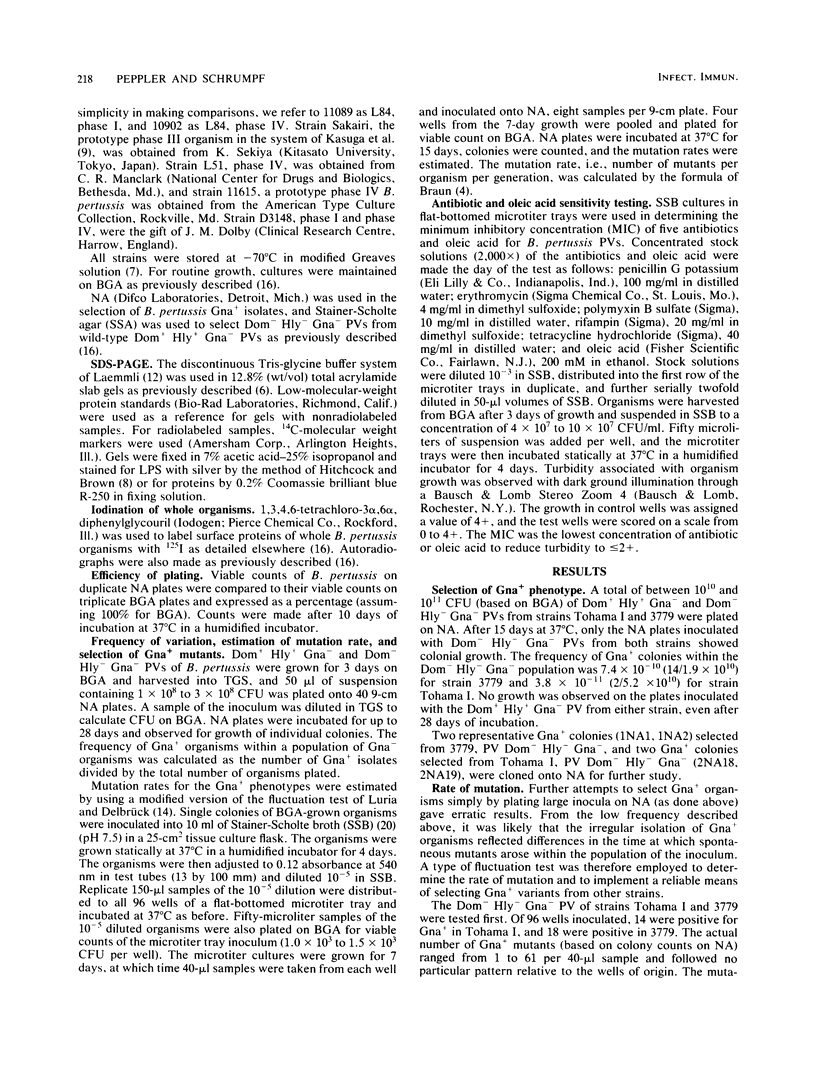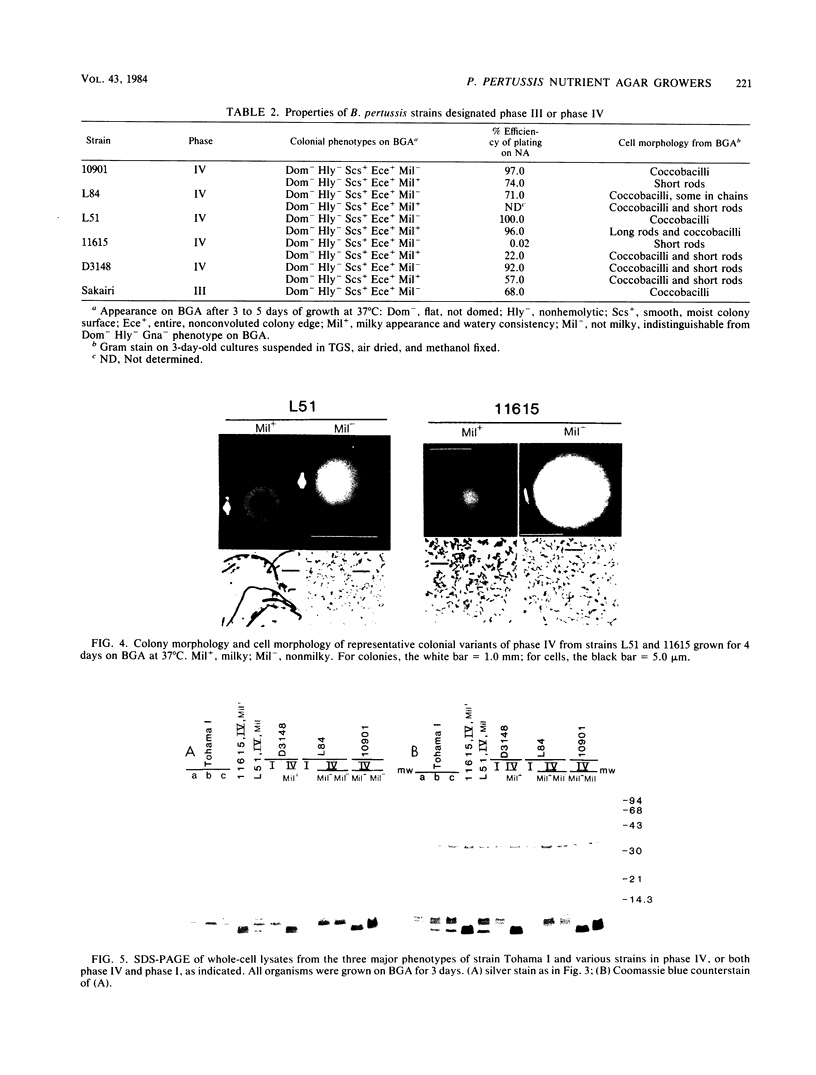Abstract
Unsupplemented nutrient agar (NA) was used to select spontaneous phenotype variants (PVs) of Bordetella pertussis Tohama I and 3779 which, by their growth on NA, could possibly be considered equivalent to phase IV in the system of Leslie and Gardner (P.H. Leslie and A.D. Gardner, J. Hyg. 31:423-434, 1931) or phase III in the system of Kasuga et al. (T. Kasuga, Y. Nakase, K. Ukishima, and K. Takatsu, Kitasato Arch. Exp. Med. 26:121-134, 1953). NA growers (Gna+) were selected from the flat, nonhemolytic, non-NA grower (Dom- Hly- Gna-) PV of both strains at a rate of between 10(-7) to 10(-8) per cell per generation. When cultured on Bordet-Gengou agar (BGA), more than one colony type was observed in strain 3779; these all retained the Gna+ characteristic during 10 to 30 passages on BGA. Analysis of 125I-surface-labeled whole cells by sodium dodecyl sulfate-polyacrylamide gel electrophoresis revealed no major changes between the Dom- Hly- Gna+ PV and their Dom- Hly- Gna- PV parents in polypeptide profile (by Coomassie stain), in surface exposure of proteins (by autoradiography), or in lipopolysaccharide profile (by silver stain). Increased resistance to oleic acid, tetracycline, erythromycin, rifampin, and penicillin G, however, was characteristic for the Dom- Hly- Gna+ PV. Five phase IV strains and a phase III B. pertussis strain had similar antibiotic and oleic acid sensitivity profiles as the Dom- Hly- Gna+ isolates and plated with similar efficiency on NA, despite heterogeneity in BGA colonial morphology and lipopolysaccharide profile.
Full text
PDF






Images in this article
Selected References
These references are in PubMed. This may not be the complete list of references from this article.
- Ackers J. P., Dolby J. M. The antigen of Bordetella pertussis that induces bactericidal antibody and its relationship to protection of mice. J Gen Microbiol. 1972 Apr;70(2):371–382. doi: 10.1099/00221287-70-2-371. [DOI] [PubMed] [Google Scholar]
- Aprile M. A. Areexamination of phase IV Bordetella pertussis. Can J Microbiol. 1972 Dec;18(12):1793–1801. doi: 10.1139/m72-281. [DOI] [PubMed] [Google Scholar]
- Field L. H., Parker C. D. Effects of fatty acids on growth of Bordetella pertussis in defined medium. J Clin Microbiol. 1979 Jun;9(6):651–653. doi: 10.1128/jcm.9.6.651-653.1979. [DOI] [PMC free article] [PubMed] [Google Scholar]
- GREAVES R. I. Preservation of living cells by freeze-drying. Ann N Y Acad Sci. 1960 Apr 13;85:723–728. doi: 10.1111/j.1749-6632.1960.tb49992.x. [DOI] [PubMed] [Google Scholar]
- Hitchcock P. J., Brown T. M. Morphological heterogeneity among Salmonella lipopolysaccharide chemotypes in silver-stained polyacrylamide gels. J Bacteriol. 1983 Apr;154(1):269–277. doi: 10.1128/jb.154.1.269-277.1983. [DOI] [PMC free article] [PubMed] [Google Scholar]
- KASUGA T., NAKASE Y., UKISHIMA K., TAKATSU K. Studies on Haemophilis pertussis. III. Some properties of each phase of H. pertussis. Kitasato Arch Exp Med. 1954 Sep;27(3):37–47. [PubMed] [Google Scholar]
- KASUGA T., NAKASE Y., UKISHIMA K., TAKATSU K. Studies on Haemophilus pertussis. I. Antigen structure of H. pertussis and its phases. Kitasato Arch Exp Med. 1953 Nov;26(2-3):121–133. [PubMed] [Google Scholar]
- Kumazawa N. H., Yoshikawa M. Conversion of Bordetella pertussis to Bordetella parapertussis. J Hyg (Lond) 1978 Aug;81(1):15–23. doi: 10.1017/s0022172400053729. [DOI] [PMC free article] [PubMed] [Google Scholar]
- Laemmli U. K. Cleavage of structural proteins during the assembly of the head of bacteriophage T4. Nature. 1970 Aug 15;227(5259):680–685. doi: 10.1038/227680a0. [DOI] [PubMed] [Google Scholar]
- Luria S. E., Delbrück M. Mutations of Bacteria from Virus Sensitivity to Virus Resistance. Genetics. 1943 Nov;28(6):491–511. doi: 10.1093/genetics/28.6.491. [DOI] [PMC free article] [PubMed] [Google Scholar]
- Peppler M. S. Isolation and characterization of isogenic pairs of domed hemolytic and flat nonhemolytic colony types of Bordetella pertussis. Infect Immun. 1982 Mar;35(3):840–851. doi: 10.1128/iai.35.3.840-851.1982. [DOI] [PMC free article] [PubMed] [Google Scholar]
- Peppler M. S. Two physically and serologically distinct lipopolysaccharide profiles in strains of Bordetella pertussis and their phenotype variants. Infect Immun. 1984 Jan;43(1):224–232. doi: 10.1128/iai.43.1.224-232.1984. [DOI] [PMC free article] [PubMed] [Google Scholar]
- Silverman M., Simon M. Phase variation: genetic analysis of switching mutants. Cell. 1980 Apr;19(4):845–854. doi: 10.1016/0092-8674(80)90075-6. [DOI] [PubMed] [Google Scholar]
- Stainer D. W., Scholte M. J. A simple chemically defined medium for the production of phase I Bordetella pertussis. J Gen Microbiol. 1970 Oct;63(2):211–220. doi: 10.1099/00221287-63-2-211. [DOI] [PubMed] [Google Scholar]
- Wardlaw A. C., Parton R., Hooker M. J. Loss of protective antigen, histamine-sensitising factor and envelope polypeptides in cultural variants of Bordetella pertussis. J Med Microbiol. 1976 Feb;9(1):89–100. doi: 10.1099/00222615-9-1-89. [DOI] [PubMed] [Google Scholar]
- Watanabe M., Nakase Y. Mutant of Bordetella pertussis which lacks ability to produce filamentous hemagglutinin. Infect Immun. 1982 Mar;35(3):1018–1023. doi: 10.1128/iai.35.3.1018-1023.1982. [DOI] [PMC free article] [PubMed] [Google Scholar]







